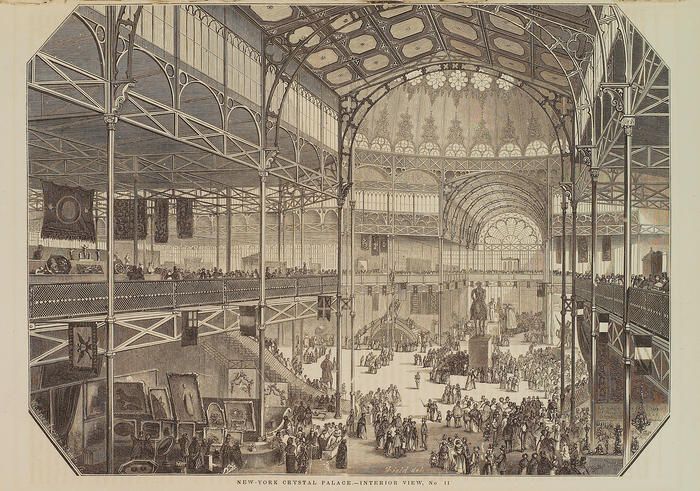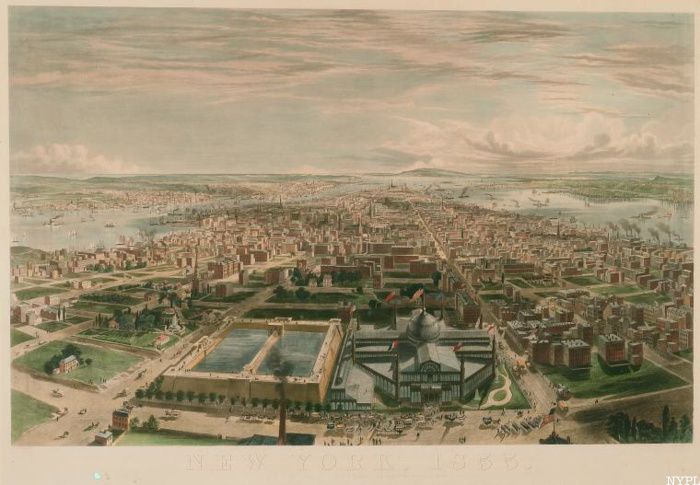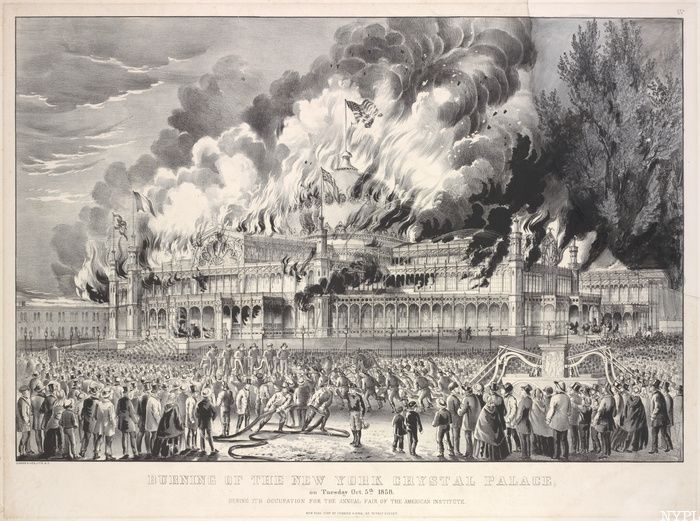✨You Can Touch the Times Square New Year's Eve Ball!
Find out how you can take home a piece of the old New Year's Eve ball!


Before Flushing Meadows-Corona Park was transformed to accommodate the World’s Fairs of 1939 and 1964, America’s first World’s Fair took over Bryant Park in midtown Manhattan. The centerpiece of that fair in 1853 was the Crystal Palace, an impressive dome-topped glass structure that took up two blocks from 40th to 42nd Street. At the time, it was the largest building in the western hemisphere. Deemed “The Finest Building in America,” the Crystal Palace made New York City a must-visit travel destination, but it was sadly short-lived.
In our on-demand video archive, Untapped New York's Chief Experience Officer, Justin Rivers, talks about the history of this lost building!
The Crystal Palace was designed by architects Georg J. B. Carstensen and Charles Gildermeister. It was built to house the Exhibition of Industry of All Nations, a global exhibition that is largely considered America’s first World’s Fair. The design was inspired by the Crytal Palace built in Hyde Park, London, for the Great Exhibition of 1851. Carstensen and Gildermeister’s Palace took the shape of a Greek cross that stretched from the Croton Reservoir Distributing Center that once stood where the New York Public Library is now to Sixth Avenue. One of the best views of the Crystal Palace itself was seen from the top of the reservoir walls. The Palace’s frame was made of steel and cast iron, and it was topped off with a large glass dome at the center.

The massive scale, expansive walls of glass, and beautifully ornate wrought iron details of the building made it an impressive sight to behold. Inside, there were even more wonders to explore. Visitors to the fair were wowed by the most technologically advanced inventions of the era at the Exhibition of Industry of All Nations. One notable invention that made its debut at the fair was Elisha Otis’s elevator. Visitors could also admire fine art from all around the world. Another attraction that drew visitors to the Exhibition was the Crystal Palace’s neighbor, the Latting Observatory. At more than 300 feet tall, it was the tallest manmade perch on the continent at the time. It quite literally brought New Yorkers to new heights (without the use of Otis’ elevator!).

Both the Crystal Palace and Latting Observatory made New York City a tourist destination. The structures were modern marvels that visitors flocked to New York City to see in person. The attention on New York’s Reservoir Square, as the area was known before the park, helped advance midtown development. Before the Exhibition of Industry of All Nations, the land where Bryant Park is now was a potter’s field, and the surrounding area was drastically less populated than Lower Manhattan.
Sadly, the Crystal Palace would not survive much longer than the run of the Exhibition. After the fair closed in November 1854, the building was leased as a special events space. It became the new home of the Fair of the American Institute, an event similar to the World’s Fair but smaller in scale. Just four years later, in October 1858, the gleaming structure was destroyed in a raging fire. In his book, The Finest Building in America: The New York Crystal Palace 1883-1885, author Edwin G. Burrows describes how “flames enveloped the dome throwing ‘great waves of lurid light’ over a throng of spectators” before it collapsed “‘with a tremendous crash,’ taking down the remainder of the roof and causing the outer walls to cave in.”

The cause of the fire was not immediately clear. Some blamed arson, though the authorities were never able to name a suspect. Others blamed alleged flaws in the building’s design. One eyewitness believed the building came down after a rupture in the gas line because the gas pipes were made of latex rather than wrought iron. However, a representative of the company who installed the pipes swore they were all wrought iron, and there was no evidence to suggest otherwise. To this day, the true cause of the fire remains unknown. Though the Crystal Palace no longer stands, we have the recollections of those who visited, artistic sketches, a few rare photographs, and the lingering mystery of its demise to remember it by.

Track down abandoned buildings, buried time capsules, and works of art leftover from the World's Fairs that Queens hosted twice!
Next, check out 12 Buildings That Should Be Brought Back in NYC and This Week in NYC History: America’s First World’s Fair Opens on July 14, 1853
Subscribe to our newsletter